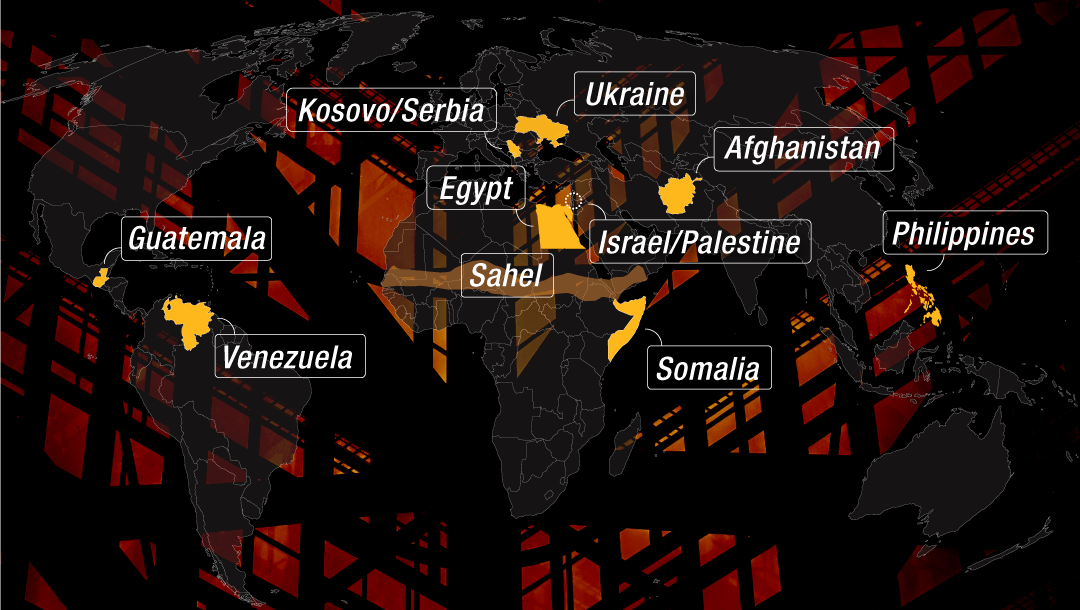World at War: Unfolding Conflicts and Rising Tensions Across the Globe in 2024

World at War: Unfolding Conflicts and Rising Tensions Across the Globe in 2024
As of 2024, numerous countries around the world are involved in various forms of conflict, ranging from open warfare, civil wars, and insurgencies to cold wars and regional tensions. These conflicts are often complex, involving geopolitical, ethnic, religious, and economic factors. Below is a detailed analysis of countries currently engaged in different types of conflicts.
1. Russia-Ukraine War
- Countries Involved: Russia, Ukraine (with NATO and Western nations indirectly involved)
- Type of Conflict: Full-scale conventional war.
- Duration: Ongoing since 2014, escalated in 2022.
- Nature of Conflict: Russia’s invasion of Ukraine has resulted in a prolonged war with intense fighting, leading to severe casualties and displacement. NATO has provided substantial military aid to Ukraine, while Western nations imposed economic sanctions on Russia.
2. Israel-Palestine Conflict
- Countries Involved: Israel, Palestine (Hamas, Palestinian Authority)
- Type of Conflict: Long-standing territorial conflict with periodic escalations into warfare.
- Duration: Since 1948, with regular escalations.
- Nature of Conflict: The Israel-Palestine conflict, centered around territorial disputes, regularly erupts into armed confrontations. Periodic escalations, such as the recent clashes in Gaza, continue to result in civilian casualties.
3. Yemen Civil War
- Countries Involved: Yemen (Houthi rebels vs. internationally recognized government), Saudi Arabia, UAE, Iran (proxy involvement).
- Type of Conflict: Civil war with international intervention.
- Duration: Since 2014.
- Nature of Conflict: The war in Yemen pits the Iran-backed Houthi rebels against the Saudi Arabia-led coalition supporting the Yemeni government. The humanitarian crisis has been severe, with millions of people at risk of famine.
4. Ethiopia-Tigray Conflict
- Countries Involved: Ethiopia (Ethiopian government vs. Tigray People’s Liberation Front, TPLF), Eritrea (support for Ethiopian forces).
- Type of Conflict: Civil war with external intervention.
- Duration: Ongoing since 2020.
- Nature of Conflict: Ethnic tensions and political disputes led to conflict in Ethiopia’s Tigray region. Despite ceasefires, sporadic fighting and ethnic violence continue, exacerbating the humanitarian situation.
5. Syria Civil War
- Countries Involved: Syria (government vs. rebel factions, ISIS), Russia, Turkey, Iran, the U.S. (indirect).
- Type of Conflict: Civil war with foreign interventions.
- Duration: Ongoing since 2011.
- Nature of Conflict: Syria’s civil war has fragmented the country into zones controlled by various factions. Foreign powers like Russia and Turkey have military presences in different regions, while remnants of ISIS still pose a threat.
6. Afghanistan Insurgency
- Countries Involved: Afghanistan (Taliban-led government vs. ISIS-K and anti-Taliban groups).
- Type of Conflict: Insurgency.
- Duration: Ongoing since 2021 after the Taliban takeover.
- Nature of Conflict: Following the U.S. withdrawal in 2021, Afghanistan has been under Taliban control. However, the Taliban faces resistance from ISIS-K and other anti-government factions, leading to continued violence.
7. Sudan Civil War
- Countries Involved: Sudan (Sudanese Armed Forces vs. Rapid Support Forces, RSF).
- Type of Conflict: Civil war.
- Duration: Ongoing since 2023.
- Nature of Conflict: Tensions between rival military factions in Sudan escalated into a full-scale civil war, leading to widespread destruction, civilian deaths, and mass displacement.
8. Myanmar Civil Conflict
- Countries Involved: Myanmar (military junta vs. ethnic armed groups, pro-democracy forces).
- Type of Conflict: Civil war and ethnic insurgency.
- Duration: Ongoing since 2021 (post-coup).
- Nature of Conflict: Following the military coup in 2021, Myanmar has faced a widespread armed resistance from pro-democracy forces and ethnic minority insurgents, resulting in a brutal crackdown by the junta.
9. Democratic Republic of the Congo (DRC) Conflict
- Countries Involved: DRC (government vs. various rebel groups, including M23, ADF).
- Type of Conflict: Civil war, insurgency.
- Duration: Ongoing since the 1990s, with multiple phases of conflict.
- Nature of Conflict: The DRC is plagued by conflict between government forces and multiple armed groups, often motivated by ethnic tensions and control over resources.
10. Armenia-Azerbaijan (Nagorno-Karabakh) Conflict
- Countries Involved: Armenia, Azerbaijan.
- Type of Conflict: Interstate conflict over disputed territory.
- Duration: Ongoing, with regular flare-ups since the 1990s.
- Nature of Conflict: The Nagorno-Karabakh region has been a flashpoint for conflict between Armenia and Azerbaijan. A recent ceasefire has not entirely resolved tensions, and sporadic clashes continue.
11. Cold Wars and Geopolitical Tensions
- U.S.-China Rivalry: While not a conventional war, the U.S. and China are engaged in a geopolitical struggle, with tensions over trade, technology, and military presence in the Indo-Pacific region. Both countries are ramping up military capabilities, and the situation around Taiwan remains a flashpoint.
- India-China Border Dispute: India and China have unresolved border disputes, particularly in the Ladakh region. While large-scale warfare has been avoided, skirmishes have occurred, and both nations are enhancing their military presence along the Line of Actual Control (LAC).
12. Other Civil Wars and Insurgencies
- Libya: Ongoing civil strife between rival governments and militias.
- Mali, Burkina Faso, Niger: Increasing instability due to Islamist insurgencies and military coups.
- Colombia: Sporadic conflict between the government and remnants of rebel groups like the ELN and dissident FARC factions.
Conclusion: A Global Landscape of War and Tension
In 2024, there are over 20 countries involved in some form of warfare, from conventional battles to civil wars and insurgencies. The causes of these conflicts are diverse, but common threads include territorial disputes, ethnic divisions, religious extremism, and political power struggles. As global powers like the U.S., China, Russia, and regional actors remain deeply involved in proxy wars and geopolitical rivalries, the potential for escalation remains a serious concern.